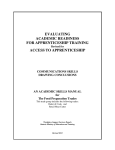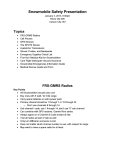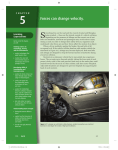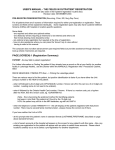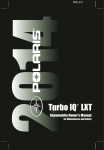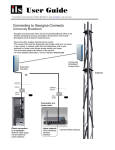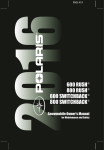Download Drawing Conclusions
Transcript
EVALUATING ACADEMIC READINESS FOR APPRENTICESHIP TRAINING Revised for ACCESS TO APPRENTICESHIP COMMUNICATIONS SKILLS DRAWING CONCLUSIONS AN ACADEMIC SKILLS MANUAL for The Motive Power Service Trades This trade group includes the following trades: Automotive Service Technician, Heavy Duty Equipment Mechanic, Motive Power Parts Person, Transmission Mechanic, Truck & Coach Technician, and Truck & Trailer Service Technician Workplace Support Services Branch Ontario Ministry of Training, Colleges and Universities Revised 2011 In preparing these Academic Skills Manuals, we have used passages, diagrams and questions similar to those an apprentice might find in a text, guide or trade manual. The information in them is not intended to instruct you in your trade. Trade related material is used only to demonstrate how understanding an academic skill will help you find and use the information you need. COMMUNICATIONS SKILLS: DRAWING CONCLUSIONS An academic skill required for the study of the Motive Power Service Trades INTRODUCTION Drawing conclusions means makings decision through a process of reasoning. It involves finding facts, examining opinions, and determining causes and effects. From this background, the relevant information is selected and used to reason through to the best conclusion. For example, your cutting shears won’t get through a piece of metal that you need to cut. What conclusion can you draw that might lead to a solution to the problem? First you look for the relevant information. You check the manual to find out what kind of shears should be used for this type of metal. You observe the strength of the shears and their condition, and the thickness of the metal. You reason that the dull edge on the blade is the cause of the problem. You come to the conclusion that you need to sharpen your shears. You have identified the problem and decided on a solution. As you can see, this is a useful process when you need to make a decision on the job, such as diagnosing a problem with a vehicle and coming up with the appropriate repair procedure. When you think about the connection between what you observe and what you already know, you can come to a valid conclusion. You can use this conclusion to guide you in making workplace decisions. You draw conclusions by comparing information obtained from different sources. Your information might come from texts and manuals, from listening to knowledgeable workers and teachers and from experience gained working on projects. Here is an example from an everyday situation. Example: The ice on Lake Simcoe is thin, so you decide it won't be safe to snowmobile. Knowing the condition of the ice and the weight of a machine, you conclude there's a risk of an accident. The next day, when the newspaper reports a snowmobiler went through the ice, you realize you made the right conclusion. In this skills manual, we examine the process of drawing conclusions by looking at the following: Selecting information for valid conclusions Drawing valid conclusions Recognizing conclusions Communications Skills for The Motive Power Service Trades Drawing Conclusions Page 1 Access to Apprenticeship Workplace Support Services Branch, Ontario Ministry of Training, Colleges and Universities Revised 2011 PART I SELECTING INFORMATION FOR VALID CONCLUSIONS A valid conclusion is one that is reasonable and that is based on fact as much as possible. The facts you use to draw a conclusion will come from instructors, textbooks, knowledgeable workers and your careful observations. Use this information and your experience to think through to a reasonable answer or solution – in other words, to a valid conclusion. Example: An insulator, or non-conductor, does not allow electric current to flow through it whereas current flows easily through a conductor. You discover current is flowing in a wire where it shouldn’t be; you need to know why because this is a fire safety issue. If there is no knowledgeable person available to ask, you will have to look at the wiring system for clues. Check any information you have on conductors and insulators. The information you read and your observations should help you draw a reasonable conclusion as to the cause of the problem. If you can’t find a simple cause and solution, shut off the power or the switch and wait for an electrician to come. Turning an electrical problem over to a trained technician is a reasonable conclusion in this situation. Read Passage 1 below as an example of information that might explain the reason for the problem. Passage 1 Conductors A material that allows an electric current to pass through it easily is called a conductor. Although there is no perfect conductor of electricity, conductors can be divided into three classes: good, medium and poor. Insulators (Non-Conductors) If a material does not allow enough electric current to pass through it to be calculated, it is called an insulator or non-conductor. Although there is no such thing as a perfect insulator, insulators are used to prevent electricity from flowing where it is not desired. Note: Moisture has the ability to change an insulator into a poor conductor; it has the ability to change a poor conductor into a medium conductor. When you start reading this passage you might think that the problem is with an insulating material – maybe a wire has been nicked. Then you see the reminder about moisture and recall the dampness in the basement. You conclude that moisture is a more likely source of the problem. Looking for moisture somewhere near the electrical system is the first thing you should do. If you don’t find a source of moisture, you need to keep looking for other reasons for the problem, so you can reach a valid conclusion. Communications Skills for The Motive Power Service Trades Drawing Conclusions Page 2 Access to Apprenticeship Workplace Support Services Branch, Ontario Ministry of Training, Colleges and Universities Revised 2011 Understanding Relationships Drawing a valid conclusion often depends on understanding the relationship between two things. To discover the connection between the cause of a problem and its effect, such as the situation above, you might follow these steps: You look for information and read that moisture has an effect on an insulator. You conclude that this effect could be a possible reason for the problem. You go back and look for moisture at the site If there is moisture, you can conclude that this is a possible cause. It there is no moisture, you need to keep looking. In either case, you reasonably conclude that this is a situation for an experienced electrician. These steps are useful when you have a problem to solve. In many cases, looking at the relationship between different parts of a system will lead you to a reason for the problem. If one thing is not working the way it is supposed to, it can lead to difficulties in many areas. Using the following steps to observe cause and effect relationships can often lead to a solution or even prevent a problem in the first place. 1. 2. 3. 4. 5. 6. You observe the situation You find information about what might cause this situation. You compare your information to what you see. You reach a conclusion about a likely cause. You check to see if the conclusion seems reasonable. You decide on an action based on your conclusion. Passage 2 describes factors that affect the performance of bearings. Read Passage 2 and answer the questions that follow. Answers are at the end of this skill manual. Passage 2 Surface Finish of Journal and Bearing The surface finish of both the journal (the part of the shaft, axle or spindle that turns in a bearing) and the bearing affects the amount of contact between the metal surfaces. Metals can be kept separated from each other with very thin oil if surface finishes are also very fine. This ensures satisfactory bearing performance. A surface may feel smooth to the touch, but it will show peaks and valleys when magnified. These saw-toothed projections are smoothed out or worn down by a run-in (wear-in or break-in) period. After the run-in period, the surfaces will have a high degree of smoothness. The peaks will be reduced and flattened, sharp edges will be rounded, and surface variations between peaks and valleys will be reduced. With smoothed surfaces, a very thin oil film keeps the journal and bearing separated and the bearing can thus support heavy loads. Communications Skills for The Motive Power Service Trades Drawing Conclusions Page 3 Access to Apprenticeship Workplace Support Services Branch, Ontario Ministry of Training, Colleges and Universities Revised 2011 Questions: 1. You can conclude that satisfactory bearing performance will result from: a) smoothness of surface finishes and proper run-in period. b) very fine surface finish and very thin oil. c) a surface smooth to the touch and a reduction of heavy loads. 2. You can conclude that a change in the thickness of oil could affect: a) b) c) d) 3. the amount of contact between metal parts. the weight of the loads. the saw-toothed projections. all of the above. A smoother finish and a thicker grade of oil should result in best operating efficiency. T F 4. The proper run-in period will wear down the peaks and valleys of the journal and bearing surface. T F Passage 2 describes the importance of a proper run-in period on bearing performance. Having this information will ensure that you take the time to do a proper run-in. You can conclude from the passage that if you changed or omitted the run-in period, the result will not be satisfactory. Each step in the process is important. You need to pay attention to details because a small change can make a big difference. Machine operation, the life of the parts, their ability to support weight, and the costs of down time depend on making sound decisions. Note important details before you start a job. Read, ask questions, and use the information available to arrive at a practical conclusion as to how to carry out a job. Find out what factors will have an effect on the result. You may need to experiment and do some tests to check that you have drawn a logical conclusion. PART II DRAWING VALID CONCLUSIONS Sometimes you know the result, but not the exact cause. Example: When you read the newspaper report about the snowmobiler going through the ice on Lake Simcoe, you concluded that the ice was too thin for snowmobiling. This is probably true, but there could also be other factors involved. You might have a good idea of what happened but you might be missing some of the reasons for the accident. Bad visibility, being unfamiliar with the lake and travelling over an area of strong currents could be factors in the snowmobile accident. Thin ice was the cause of the accident but you don’t know why the snowmobiler drove over unsafe ice in the first place. Communications Skills for The Motive Power Service Trades Drawing Conclusions Page 4 Access to Apprenticeship Workplace Support Services Branch, Ontario Ministry of Training, Colleges and Universities Revised 2011 Getting all the Pieces The same principle applies to paying attention to all the information concerning procedures you use at your workplace. If you make quick observations or if you skim through your manual, you might go ahead, assuming that you have all the pieces. But there is also the possibility that you have missed something. You can’t draw a valid conclusion or find a solution to a problem if you overlook important, available information. A valid conclusion relies on having, and examining, all of the information important to that situation. Read Passage 3 below. Consider the conclusions you could draw with the information given. Answer the questions that follow. Answers are at the end of this skill manual. Passage 3 Two-cycle Fuel Mixtures Most two-cycle engines are lubricated by oil that is mixed with gasoline. The correct quantity and quality of oil must be mixed in the correct proportions. Even with the correct proportions, a two-cycle engine can be seriously damaged if the gasoline and oil are not mixed properly. To ensure they are properly mixed, first pour some of the gasoline into a clean container. Next, the oil is added to the gasoline and shaken (agitated). The remainder of the gasoline is then added and agitated again thoroughly. If stored for several weeks, add a gasoline stabilizer so that oxidation, varnish and corrosive acids do not form. These can ruin an engine. Too little oil can cause the engine to overheat. Overheating causes parts to expand, this expansion may result in scoring of machined surfaces. As a result, the pistons may eventually seize in the cylinders. Too much oil will cause incomplete combustion resulting in rapid buildup of carbon. This will foul spark plugs and add weight to the pistons. Questions: 1. If the engine overheats, you might conclude the following: a) b) c) d) oil and gas were not properly mixed. oil and gas were not mixed in the proper proportions. the fuel was not properly stored. all of the above. 2. You can conclude that too much or too little oil will be the cause of fouled spark plugs. T F 3. From this passage, what type of engine damage would result from improper storage of fuel? a) b) c) d) scoring of machined surfaces sluggish pistons corrosion of parts none of the above 4. Piston damage could result from too little or too much oil. T F Communications Skills for The Motive Power Service Trades Drawing Conclusions Page 5 Access to Apprenticeship Workplace Support Services Branch, Ontario Ministry of Training, Colleges and Universities Revised 2011 Getting the whole picture Factors which are not stated may also affect the results of a job. For example, suppose you followed the sequence outlined in Passage 3, and still produced a weak or poor weld. Is something else different? Is your equipment up to standard? Is the angle of weld or your technique not what it should be? Is there something you didn’t understand? When looking for the cause of a problem, you usually start with the obvious reasons. But sometimes you need to check out everything. Make sure you don’t reach a conclusion based on only part of the information. You want all the available information before drawing a conclusion. Always get the whole picture first. Example: Suppose you work in an area with gas engines and motors. After a few months you come down with flu symptoms - headaches, dizziness and nausea. The symptoms hang on and you see your doctor. Your doctor asks if there are any factors at work that might cause the symptoms but you say everything seems fine. You and the doctor decide this is just a nasty bug. You carry on at work but the flu symptoms don't go away. A few weeks later you notice the following warning on a piece of machinery where you are working: NOTE: Use only in a well-ventilated area. Fumes from this machine can accumulate in the body and cause flu-like symptoms. You wonder if your flu-like symptoms are caused by lack of ventilation. You make sure the window is open and the fan is running from now on when you are working on that machine. You look for changes in your health over the next weeks. Soon your illness is gone. Can you conclude that lack of ventilation caused the problem? From your observations, it seems likely. You can now act on this conclusion by making sure your work area is properly ventilated. In this example, your first conclusion was that you had the flu. You based this on your past experiences. It felt like other flu that you have had. However, when the flu didn’t get better, you realized that there may be another reason for your symptoms. From the information about fumes, you learned about another factor that might be causing the problem. You acted on that information by providing better ventilation and your symptoms disappeared. You drew a new conclusion based on further information and observation. Is it a valid conclusion? If a first conclusion doesn’t provide a practical solution, you have to keep looking. When you add new information, you should then be able to draw a different, and more valid, conclusion. In other words, new information can lead to a new conclusion when the first conclusion is not valid. Communications Skills for The Motive Power Service Trades Drawing Conclusions Page 6 Access to Apprenticeship Workplace Support Services Branch, Ontario Ministry of Training, Colleges and Universities Revised 2011 Making an estimate about a job is one form of drawing a conclusion. To come up with a reasonable estimate requires several steps You have to know what options are available. You have to find out the cost of each option. You have to compare the advantages and disadvantages of each option. Then you have to weigh the cost against the advantages and disadvantages. You will have to decide what the most important factors are in making this decision. Reaching a final estimate involves coming to a conclusion as to what the best option is for the cost. You can now present this estimate to the customer along with reasons for your choices. To make sound decisions in the motive power trade, you study information in texts, manuals and diagrams so that you learn the material and can apply it. You observe different factors in the workplace for the same reason - so you can understand and evaluate what you see. What you read (theory) and what you do (practice) are essential to making good decisions. You read and learn when working with written material; you observe and learn when gaining hands-on experience. Example: You experience a mild shock while drilling. You take a good look at your drill and notice that the cord is frayed. You know from your reading that frayed cords can cause shocks. After concluding that the frayed cord is the cause of the electrical shock, you unplug the drill carefully and set it aside until the cord is replaced. Read Passage 4 and answer the questions that follow. Answers are at the end of this skill manual. Passage 4 Re-boring a Cylinder Cast-in sleeve or solid cast iron cylinders can be re-bored to a larger size. The objective is to maintain the original alignment while producing a round, straight bore, and then to produce the correct wall finish in the cylinder. Usually, cylinders are re-bored in .010" steps (see metric equivalent). This means that the first boring will increase the cylinder diameter by .010" over the standard size. The next step will increase the diameter by another .010" so the bore will now be .020" over standard size. The pistons and rings must be ordered in sizes .010" or .020" over standard to match the re-bored cylinder. Proper honing removes the surface fractures and furrows left and will thus produce the required cylinder wall finish. The properly honed cylinder should wear smooth at the same rate as the new piston rings wear in. This break-in period should ensure that piston rings and cylinder would last for hundreds of engine operation hours. Questions: 1. If the diameter of a re-bored cylinder is .030" over standard size, you could conclude that removing imperfections in the cylinder requires three steps. T F Communications Skills for The Motive Power Service Trades Drawing Conclusions Page 7 Access to Apprenticeship Workplace Support Services Branch, Ontario Ministry of Training, Colleges and Universities Revised 2011 2. You could conclude that an unsatisfactory wall finish is a result of omitting the honing process. T F 3. Choose the best conclusion when you discover pistons and rings do not match the rebored cylinder. a) The re-bored cylinder size was not calculated correctly. b) The pistons and rings are faulty. c) The break-in period was not long enough. In this passage, you learn about factors that will result in a properly aligned cylinder. When you understand the relationships between such factors, you can draw conclusions that will get you reasonable results. You can also look for reasons when a boring is not up to trade standards. You conclude that you will get you the best results for engine operation by following these directions exactly. Look ahead When you read technical information such as the passages about fuel mixtures and re-boring cylinders, you obtain facts that you can use to make predictions. To make a prediction, you must read the instructions and then think ahead to what the outcome of following those steps might be You can predict that your outcome will be successful if you follow the provided instructions, use the right equipment and give yourself enough time for the job. You can also predict that you will not get the right result if you do not follow the directions exactly or if you work without the required knowledge and skills. Note: Because of other factors – unknown to you or overlooked – this may not result in a valid conclusion. If you do not arrive at the correct conclusion, you will have to continue researching until you discover it. Look behind You can turn the process of drawing conclusions around by looking backwards. If you discover a problem, you’ll need to go back to find a cause. You may have to go through the instructions sentence-by-sentence. After reading the information again, check your technique and tools, and then observe what is actually happening on the job. This will help you to identify the cause of the problem. Then you can draw a conclusion that will let you figure out how to avoid the problem next time. Process of elimination The examples in this unit ask you to use a process of reasoning for several reasons. You might want to: decide what is the best way to proceed, choose a material, find an answer to a question, or find a solution to problem. Communications Skills for The Motive Power Service Trades Drawing Conclusions Page 8 Access to Apprenticeship Workplace Support Services Branch, Ontario Ministry of Training, Colleges and Universities Revised 2011 To come to a reasonable conclusion in these cases, you might use a process of eliminating possibilities. You make a preliminary selection between possible choices as a way of getting started. First, you try to eliminate the least likely or the weakest possibilities first. Next you look carefully at the more likely possibilities, based on your reading and experience. Then you pick what looks like the best choice. If you get more information or if your choice doesn’t seem to be working out, you start the process over. You might have to look for more options to consider. As you begin to see the relationship between various factors, you can begin to draw conclusions that work for your situation. Example: You know that a change in altitude means a change in atmospheric pressure. If you are working at a different altitude than sea level, you conclude that a pressure gauge will not give you an accurate reading unless it is adjusted. Drawing this conclusion will lead you to check your equipment before you use it and to make the proper adjustments. Is this valid? When you observe what happens in the workplace, you use what you see to draw conclusions about what works and what doesn’t. At some point, you have to decide if your conclusions are valid. Often when you draw a conclusion, you need more testing or examples to be sure it is valid. If an outcome happens once during project, you can’t be sure it will always happen that way. More examples are required before you can use that outcome to make predictions. You will know the conclusion is valid if the same thing happens every time you follow that procedure. Example: You may produce a defective weld because you used the wrong filler material. However, in another situation, a defective weld may be the result of voltage that is too low. Noticing causes and results, while you are learning and while you are working, adds to your awareness of what is a valid conclusion for a given situation. With experience, you will come to instinctively figure out what is the best way to proceed. You may have overlooked other factors which affect the outcome of the finished work. If you notice that you have missed something on a project, make sure to take it into account the next time. Each factor will have an effect on the finished product. As you learn how each factor affects the process, you will work hard to develop the skills needed to reach a satisfactory conclusion. Sometimes you need to reach a conclusion quickly, perhaps about what product to choose. You don’t have time to check all the possible results of using the different products. You can ask other workers what they would choose. You can turn to an expert. You can also rely on Communications Skills for The Motive Power Service Trades Drawing Conclusions Page 9 Access to Apprenticeship Workplace Support Services Branch, Ontario Ministry of Training, Colleges and Universities Revised 2011 manufacturers’ literature. The information will often tell you what to expect. If the company is reliable, you can count on them to test their product and to guarantee them. A conclusion may be valid in one situation given the information you have available. It may not apply in another situation. Learn to judge each new situation before you draw a conclusion. Look at the relationship between cause and effect. Keep track of what happens in different situations so you have a range of possibilities from which to choose. Consider all the possibilities and keep your mind open when making conclusions. There are skills you can develop to help in making valid conclusions: 1) 2) 3) 4) 5) Observe and keep records of what happens in different situations on the job. Talk to skilled workers to add to your store of knowledge. Watch and listen as you work. Test your ability to judge a situation. Start to see patterns that can help you make reliable prediction. As you become more experienced, you will find it easier to reach valid conclusions and make logical decisions. PART III RECOGNIZING CONCLUSIONS You might be reading a text or manual and you want to decide if the information is presented in a way that you can use to draw a conclusion. Experienced workers might talk about different situations and you aren’t sure what conclusion to draw from the conversation. There are guides that help you recognize when a conclusion is being made. The language of conclusion Some words and phrases provide clues that a conclusion is being drawn. When you examine information, notice when any of these words are used. They will give you a signal that the writer is drawing a conclusion. The words therefore, must have (must be) and would have to be often indicate that a conclusion is being drawn: Example: You look for the cause of engine vibration. If you see a broken mount, and you know that a broken mount causes excessive vibration, you might say, “The vibration must be happening because of this broken mount.” Example: In another case, you might say something like, "It can't be the pulleys because the technician checked these. The drive belts are okay because these were checked by my supervisor; therefore it may be a broken mount." You will then check to see if your prediction is correct. Communications Skills for The Motive Power Service Trades Drawing Conclusions Page 10 Access to Apprenticeship Workplace Support Services Branch, Ontario Ministry of Training, Colleges and Universities Revised 2011 The words if, so that, due to, because of, or since often indicate that a cause and effect statement will follow. They point out the causes that lead to a result. The conclusion follows. Examples: If the spark plug is not taken out before removing the engine, it could fire accidentally or break when you disassemble parts. Since every engine make and model is built to certain dimensions and specifications, you must follow the right service manual. Due to clean air regulations, some solvents are no longer used. Because of the wide variety of tools available, procedures for misfires differ. Words such as will then, consequently, as a result, must, thus or therefore often indicate a result. Once you know the cause and result of a situation, you can often use the information to reach a conclusion. Examples: As a result of the very high temperatures that the piston is subjected to, it will expand during operation. The piston head receives the main force of combustion heat; it, therefore, runs hotter than the skirt and expands. For this reason, the head of the piston may be made with a smaller diameter than the skirt. If a tool uses more air pressure, it will then cause the air compressor to wear out faster. Another method of drawing conclusions is by turning information around. Example: Tools of high quality purchased from a reputable manufacturer have a number of advantages: most offer lifetime guaranties against failure, are lightweight and easy to handle, and hold up under use. If the above is true about high quality tools bought from a reputable manufacturer, you might conclude that the opposite is true of poor quality tools. In other words, that they do not offer lifetime guarantees against failure, are not lightweight and are not easy to handle. Although you can turn some information around, be careful not to jump to conclusions based on too little information. There may be inexpensive tools available that are a good deal and that work well. Before you draw a conclusion about tools based only on price, you might want to do some research by talking to others and reading guides that compare tools. Read the advice below about caring for measuring tools. Measuring tools must be handled with the care. 1. Never drop a square as this can ruin accuracy. 2. Always keep it clean. Communications Skills for The Motive Power Service Trades Drawing Conclusions Page 11 Access to Apprenticeship Workplace Support Services Branch, Ontario Ministry of Training, Colleges and Universities Revised 2011 Precision tools require care. Does this mean you can toss around other instruments and tools? Think about the result of this action. Drawing valid conclusions always requires a certain amount of common sense. CONCLUSION To draw valid conclusions, you must first make accurate observations. Then you compare what you see to what the information you have from textbooks and manuals. You might ask a more experienced worker for their opinion of the situation. All this information is used to reason through to a logical conclusion. After reaching a conclusion, you need to check if it seems valid in other situations. This process will gradually build up a wealth of experience that you can use to make future decisions. You will be able to quickly decide what course of action to take in various situations. This will also be useful in making a reasonable estimate. Understanding the relationship between cause and effect is a necessary step in reaching a valid conclusion. Skill in drawing conclusions will give you the ability to judge a situation accurately. You will also develop the habit of making sound decisions as you learn. This will help you develop into an efficient and effective service technician. Summary 1. Use a variety of resources to draw conclusions. These include experience, observations, advice from experts and all relevant technical reading information 2. Read technical material carefully to find information about causes, results and solutions; you can then use the information in the workplace. 3. Carefully observe what is happening in the workplace. 4. Understand the relationship between things to be able to judge cause and effect. 5. Understand that a change in a procedure, material or tool often affect something else. Notice how these changes affect the result. 6. Consider whether you have all the information needed to reach a valid conclusion. Are there factors affecting the outcome that you do not understand or don’t know about? 7. Eliminate weak possibilities to focus on the strongest and the most likely. 8. Observe language used in drawing conclusions such as therefore, thus, would have to be, must be which set up the situation and then reach a conclusion. . Communications Skills for The Motive Power Service Trades Drawing Conclusions Page 12 Access to Apprenticeship Workplace Support Services Branch, Ontario Ministry of Training, Colleges and Universities Revised 2011 Answer page PART I Passage 2, Surface Finish of Journal and Bearing 1. You can conclude that satisfactory bearing performance will result from: b) very fine surface finish and very thin oil. 2. You can conclude that a change in the thickness of oil could affect: a) the amount of contact between metal parts. 3. A smoother finish and a thicker grade of oil should result in best operating efficiency. F The passage only states, “a very thin oil film keeps the journal and bearing separated.” Would a thicker grade decrease contact and result in longer part life and smoother operation? We don’t know. We need more information. 4. The proper run-in period will wear down the peaks and valleys of the journal and bearing surface. T Paragraph two states clearly: “After the run-in period, the surfaces will have a high degree of smoothness.” PART II Passage 3, Two-cycle Fuel Mixtures 1. If the engine overheats, you might conclude the following: b) oil and gas were not mixed in the proper proportions Passage 3 tells you that too little oil (improper proportions) will cause overheating 2. You can conclude that too much or too little oil will be the cause of fouled spark plugs. T 3. From this passage, what type of engine damage would result from improper storage of fuel? d) none of the above 4. Piston damage could result from too little or too much oil. T? We’ve added a question mark to this conclusion. It seems clear that a piston that seizes (binds and sticks) from too little oil will be damaged and causes other damage as well but we don’t know if the piston itself will be damaged. This is the reason to add a question mark and look for an answer to this. PART III Passage 4, Re-boring a Cylinder 1. If the diameter of a re-bored cylinder is .030" over standard size, you could conclude that removing imperfections in the cylinder required three steps. T Each step (according to this passage) removes .010" from diameter. A cylinder .030" over standard size has been re-bored three times. Communications Skills for The Motive Power Service Trades Drawing Conclusions Page 13 Access to Apprenticeship Workplace Support Services Branch, Ontario Ministry of Training, Colleges and Universities Revised 2011 2. You could conclude that an unsatisfactory wall finish is a result of omitting the honing process. T It is the honing process that produces a satisfactory wall finish, not the boring process. 3. Choose the best conclusion when you discover pistons and rings do not match the re-bored cylinder. a) The re-bored cylinder size was not calculated correctly. Communications Skills for The Motive Power Service Trades Drawing Conclusions Page 14
















